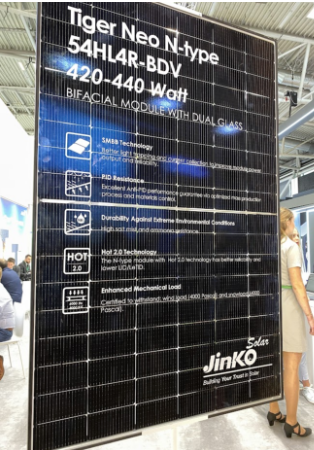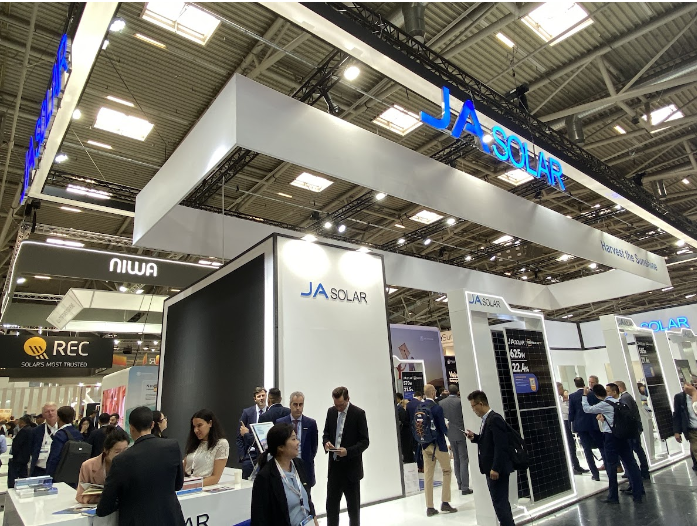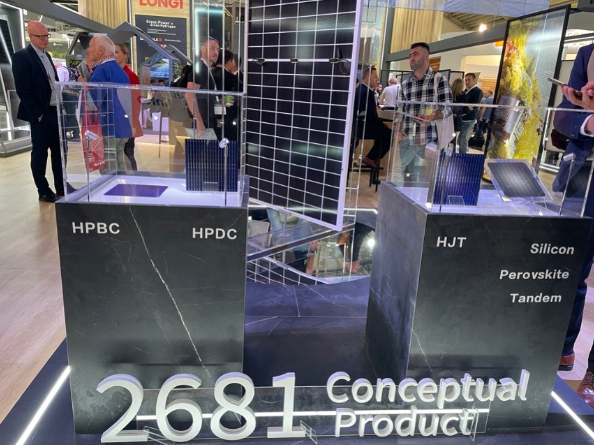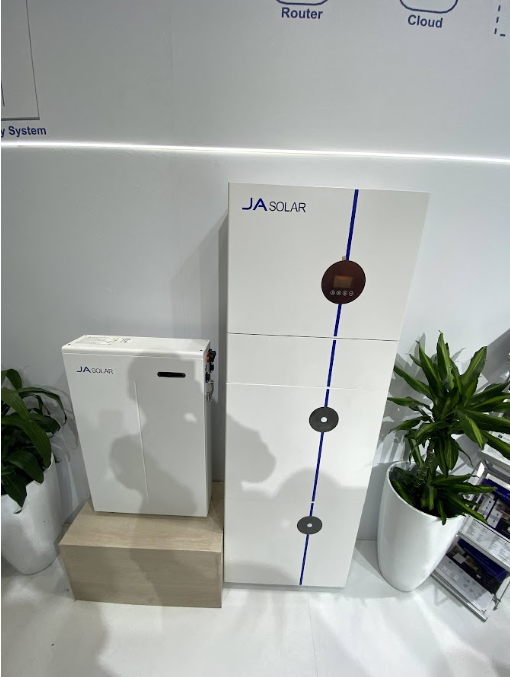Intersolar 2023 Recap
This year, Intersolar is embarking on a transformative journey with a multifaceted focus on expanding PV module production capacity, embracing innovative technologies, and preparing for the future of renewable energy integration.
As per our conversation with Carlos Magistris the Senior Technical Services Manager Europe at Jinko Solar, it appears that Jinko Solar, being one of the pioneers in N-type technology, is now achieving the results they deserve. Jinko Solar’s Tiger Neo R Series is an exceptional choice for anyone looking for high power density, top efficiency, and a high energy yield, no matter the scenario. This series covers all power demands, from 425 W to 635 W, making it ideal for residential, C&I, and utility-scale applications. The integration of N-type TOPCon HOT 2.0 technology and Slim Multi-busbar (SMBB) makes this series even more impressive, offering superior efficiency, improved carrier conductivity, better light trapping effect, and low light performance, as well as optimized temperature coefficients and minimal metallization shading. The TOPCon HOT 2.0 technology also provides an incredibly high bifaciality potential, resulting in up to 25% rear side gains under highly optimized conditions, 2-3% higher than traditional p-type modules.
Jinko Solar is so confident in the performance and reliability of their modules that they offer a 30-year performance warranty, which guarantees that the modules will experience no more than 1% degradation in the first year and a mere 0.40% annual degradation rate thereafter. With such exceptional warranties, customers can rest easy knowing that they have made a wise investment in the long-term energy sustainability of their home or business. Jinko Solar expects its annual production capacity for mono wafer, solar cell, and solar modules to reach 75.0 GW, 75.0 GW and 90.0 GW, respectively, by the end of 2023.
Jinko Solar also created a new HV battery called the RESS self-developed HV battery JKR-B1250~2750-A. It’s good for homes and small businesses because it works well and has a capacity of 3.84 kWh. The battery can handle over 6,000 cycles at room temperature. It comes in different sizes, from 11.52 to 134.4 kWh, and can connect wirelessly. It has safety features like IP65 protection and anti-fire design. The battery has a unique heating system for a wider temperature range and BMS protection logic for safety. Jinko Solar is committed to sustainability and uses a fully automated production line to save energy and improve efficiency.


Francesco Liuzza, Senior Technical Sales Engineer from JA Solar introduces DeepBlue 4.0 Pro, a game-changing module that harnesses the power of cutting-edge N-Type technology. Featuring cells cut from JA Solar’s next-generation rectangular silicon wafers, DeepBlue 4.0 Pro boasts exceptional longevity and low oxygen content. With the integration of high-efficiency N-Type passivation contact Bycium+ cell technology, the module achieves an impressive Open Circuit Voltage (Voc) of 725 mV and a mass production cell efficiency of 25.3%.
A standout feature of JA Solar DeepBlue 4.0 Pro lies in its rectangular 182 mm x 199 mm silicon wafers, allowing for versatile applications across various scenarios. Unlike other rectangular wafer sizes, these wafers maintain a width of 1134 mm while satisfying four popular module lengths: 1762 mm, 2333 mm, 2384 mm, and 2465 mm through different cutting methods. This adaptability positions DeepBlue 4.0 Pro as a versatile solution for residential rooftops, commercial and industrial rooftop systems, and utility power plants, catering to diverse application needs.
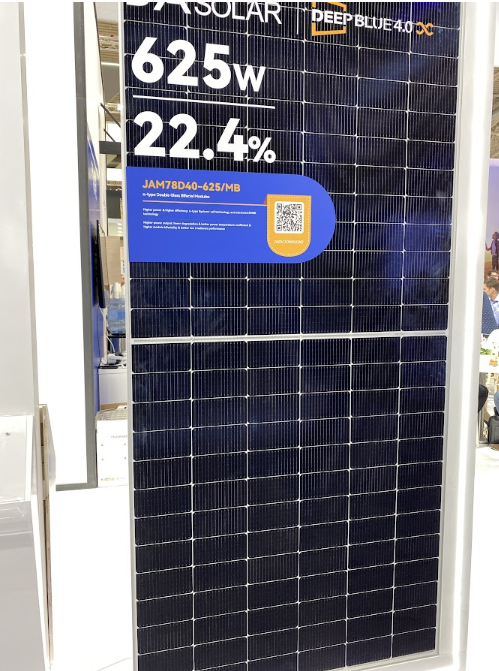
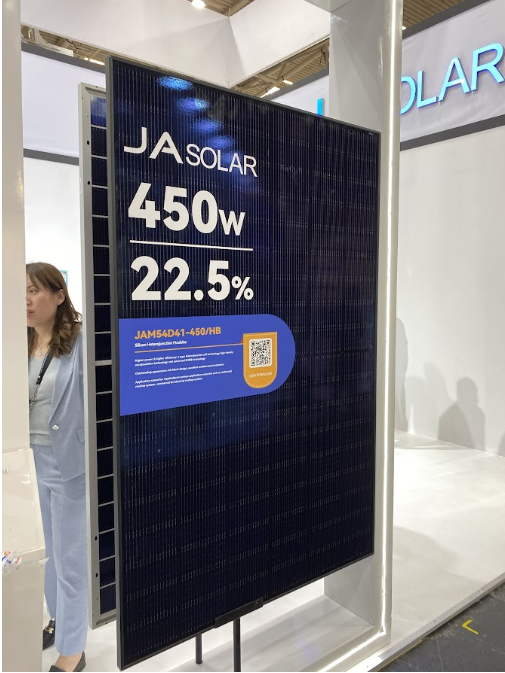
Phono Solar
Phono Solar has launched a new brand image along with their latest influential products. These include the Helios series, an N-type HJT module, and the Draco series, an N-type TOPCon module. These modules are highly efficient, with power up to 720 W, and feature a transparent design with high bifaciality and transmittance. Additionally, they offer an all-black aesthetic that is both exquisite and timeless.
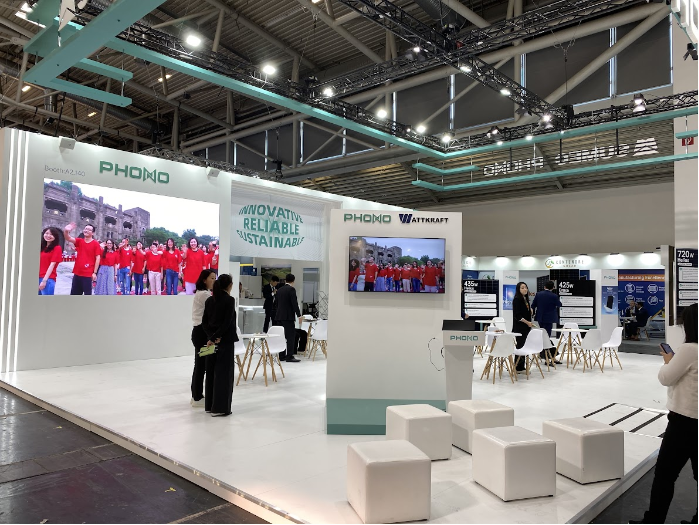
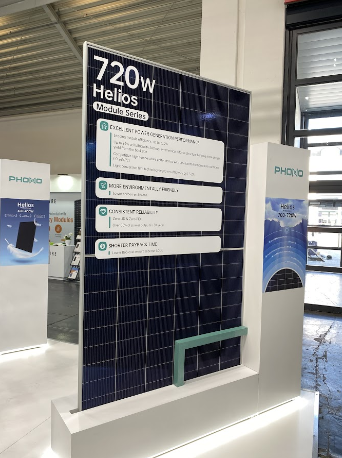
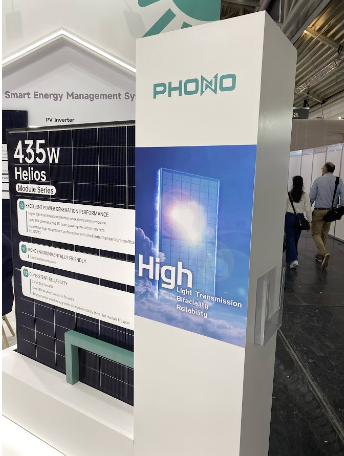
LONGi Solar
The Hi-MO 7 module launched this time is a new generation of products developed by LONGi based on high-efficiency Hybrid Passivated Dual-Junction Cell (HPDC) cell technology. It utilizes cutting-edge technology such as optimized film design, dual-junction cells, and upgraded antireflection and low-recombination films to achieve maximum efficiency. LONGi Solar Hi-MO 7 modules use the standardized M10 module size of 2278×1134 mm.

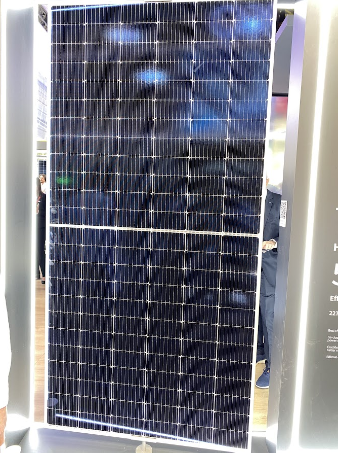
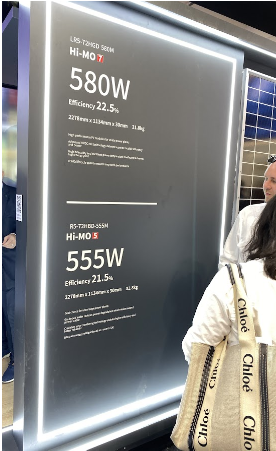
LONGi unveiled their latest achievement in the form of silicon-perovskite tandem solar cells based on commercial CZ silicon wafers. This new development has been confirmed by the European Solar Test Installation (ESTI) to have a conversion efficiency of 33.5%. LONGi also showcased their conceptual product 2681, which holds the world-record for efficiency.
Canadian Solar
Candian Solar expanded its PV module manufacturing capacity to 32 GW in 2022 and expects to reach 50 GW module manufacturing capacity by the end of 2023. This time at Intersolar, Canadian Solar showed their new TOPCon N-type module portfolio covering both 182 mm (TOPHiku6 & TOPBiHiku6) and 210 mm cells (TOPBiHiku7). When combined with N-type silicon wafers, the upper efficiency limit of TOPCon cells is estimated to be 28.7%, outclassing that of PERC, which would be about 24.5%.
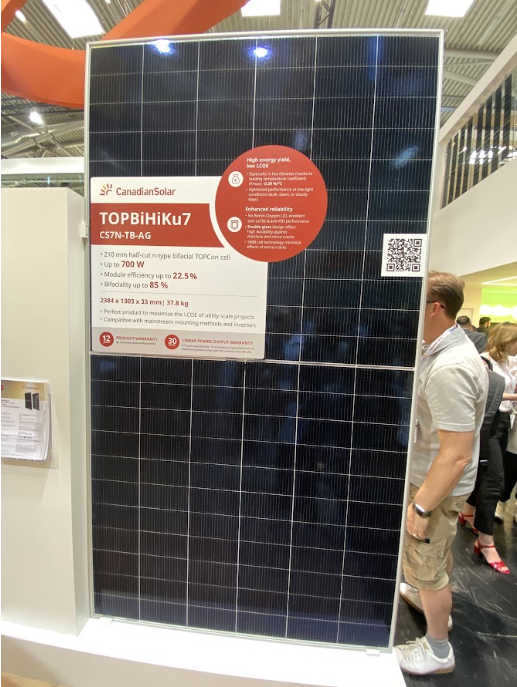
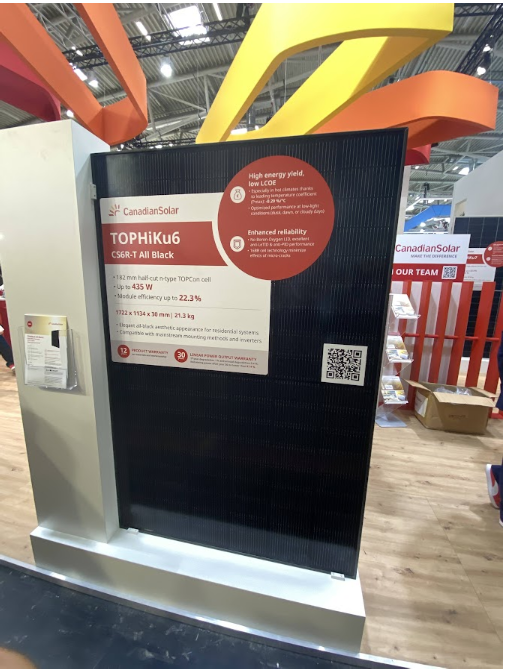
Energy storage systems for commercial and industrial (C&I) and residential applications
At Intersolar this year there has been a notable surge in the number of individuals opting for energy storage systems. A wide range of new options have emerged in the market for residential use, not only from inverter manufacturers but also from PV module manufacturers. The objective is to provide households with a simple and convenient means of acquiring all the necessary components from a single brand, with a unified warranty policy covering PV modules, inverters, energy storage, and even EV chargers. This is undoubtedly a promising period for energy storage solutions.
JA Solar and Phono Solar
SolarEdge
SolarEdge have strengthened their residential portfolio with the New Bi-Directional DC-Coupled Electric Vehicle Charger. By utilizing a DC-coupled architecture, it enables direct charging from photovoltaic (PV) panels, eliminating unnecessary AC-to-DC conversions. With the ability to draw power from the PV array, home battery, and grid simultaneously, the Charger supports fast charging of up to 24 kW. This unique design bypasses the limitations of the car’s onboard charger and the home’s AC infrastructure, optimizing the charging process for increased efficiency. Additionally, the Charger leverages SolarEdge inverters‘ DC to AC oversizing capabilities of up to 200% to charge the EV with excess PV energy.
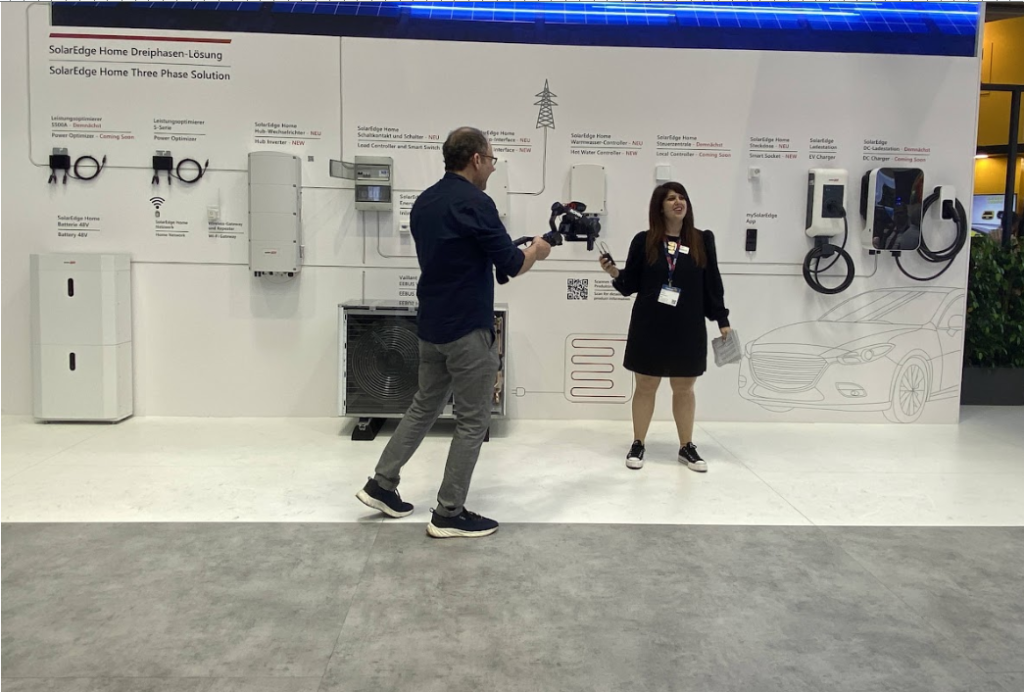
SolarEdge is also introducing a new Commercial Storage System that will be available later in 2024. This system seems like a perfect fit for small to medium commercial PV installations, with its impressive battery capacity of 58 kWh and the ability to connect up to eight batteries per inverter, providing up to 460 kWh of storage capacity. It’s also great to hear that the system will synchronize solar battery and site-level energy management. Additionally, the multi-layered suite of embedded safety features, including arc detection, will make it a safe and reliable choice for businesses seeking a dependable commercial storage solution.
SolarEdge has introduced a new solution for ground mounts in utility-scale, featuring a new optimizer documented as H1300, and a new inverter with a capacity of 330 kW. This latest addition completes SolarEdge’s portfolio, covering residential, commercial, and utility-scale applications.
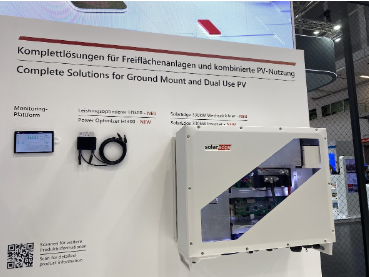
Deye
Introducing the latest addition to Deye‘s impressive range of hybrid inverters – the high voltage 50 kW model. This top-of-the-line inverter is lightweight and boasts two independent battery connection terminal ports, allowing for the use of different brand batteries simultaneously. With the ability to parallel up to 10 devices, this inverter is perfect for even the most demanding energy needs. And like all Deye hybrid solutions, it can be used in conjunction with a diesel generator, storing excess energy in the battery and providing backup power in the event of a grid outage.
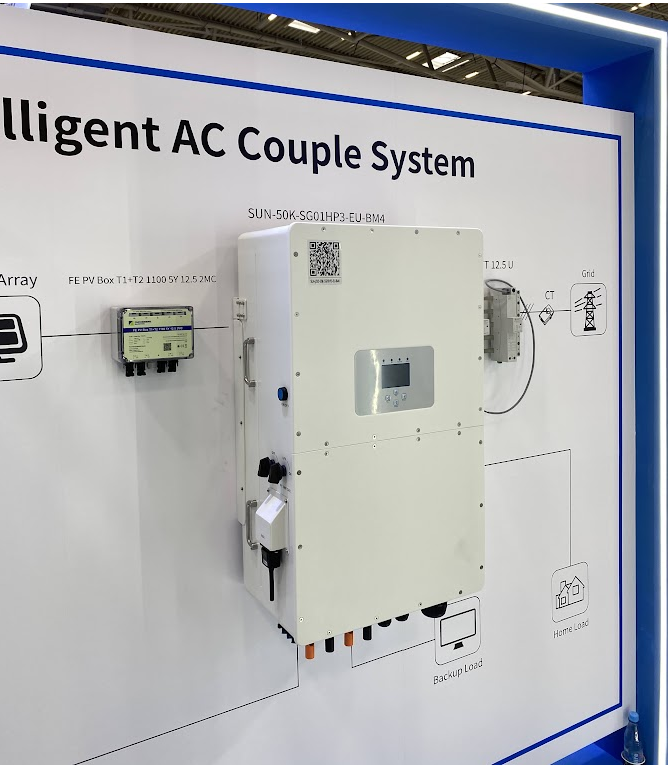
Huawei
Huawei has introduced a new residential LUNA battery solution with a higher power and capacity up to 21 kWh per stack, accompanied by a new range of battery inverters capable of achieving up to 25 kW. Additionally, a more robust backup box known as SmartGuard has been developed and is equipped with a Huawei EV smart charger and a smart controller named EMMA. It appears that EMMA is capable of managing the charging and discharging profile of the battery to maximize its potential energy output.

Huawei is proud to offer a comprehensive solution for commercial and industrial applications. This solution includes the industry’s first 1300 W optimizer that is compatible with 182/210 modules, the first series of inverters that achieve enterprise-level power supply reliability, the first 200 kWh commercial and industrial energy storage system using smart string architecture, the first 720 kW modular all-liquid-cooled supercharging system, and the first commercial and industrial intelligent management system that connects with AI from end-to-end.
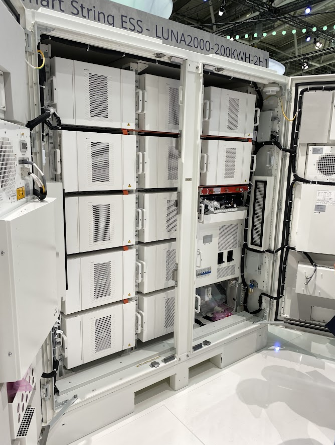

Preparation for the electric vehicle (EV) revolution
In the EV charging segment, to prepare for the electric vehicle (EV) revolution Wallbox brings a new Quasar 2 DC – Bidirectional Charger. Quasar 2 transforms your electric vehicle into an ultra-powerful energy storage system that can power your home with cheaper, cleaner energy. Their intelligent software and easy app experience mean you can access your energy on demand–whether for fast smart charging or energy-efficient living. Their next solution is Supernova, Wallbox’s next-generation DC fast-charger. Its higher efficiency and reliability maximize uptime, benefiting electric vehicle drivers and charge point operators. Supernova 60 kW and Supernova 150 kW are ideal for public charging in urban or interurban locations as well as semi-public parking lots.
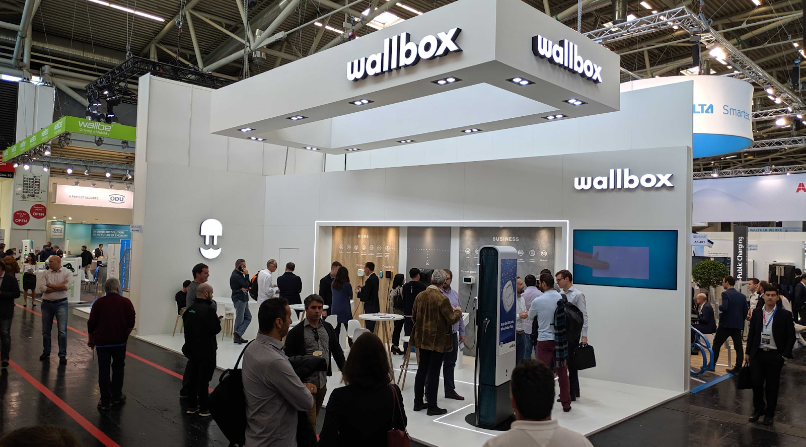

Companies with a focus on off-grid and accessory solutions, such as Victron and Weidmüller, also provide Intersolar Home EV charging solutions.
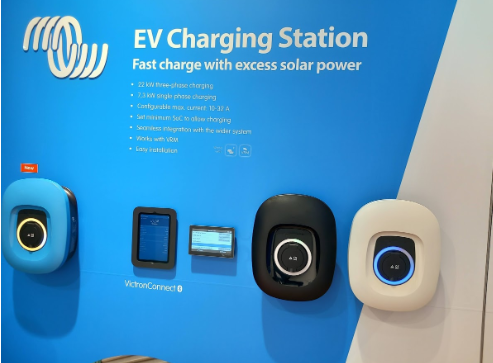

Artificial intelligence integration in optimizing renewable energy systems
With the rapid increase in PV system capacity and Battery Storage system installations, along with the growing trend of using electrical vehicles and devices like heat pumps, the need for a smart and intelligent controller to manage complex energy consumption is becoming increasingly important for the near future.
After the introduction of ChatGPT a couple of months ago, the market seems more confident in introducing solutions with artificial intelligence to upgrade the functionality of the whole system to the next level. With Huawei this is their AI Energy Management Assistant (EMMA), which provides intelligent energy scheduling and management functions. Based on big data analysis, it accurately predicts the power generation and consumption curves of households, and intelligently stores, purchases, and sells electricity to achieve optimal system performance, improve the utilization rate of PV power, and maximize financial benefits.

The German company GMC Instruments, who specialize in energy management systems, focus on safe and efficient energy everywhere. Including monitoring, analysis and visualization of electrical parameters for the control and proactive optimization of energy consumption.
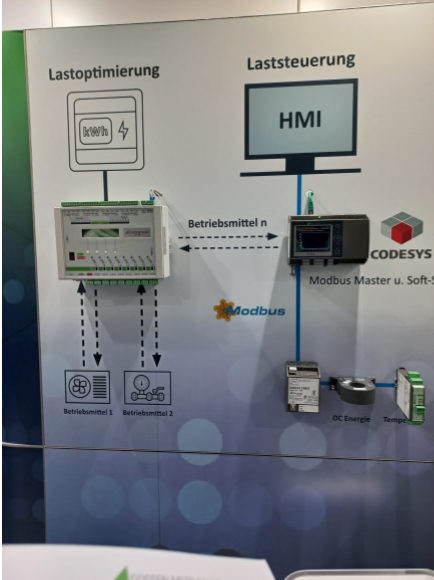

A final word
Despite the current fluctuations in the PV industry due to the decrease in the prices of polysilicon and PV modules, it is likely that in the long run, this will prove to be beneficial for people. The demand for PV system installations is constantly growing, and with lower costs, it is only expected to increase. However, in order to fully realize the potential of PV systems, it is necessary to have a large-scale PV installation storage system to ensure a reliable grid. In the residential and C&I segment, the increasing demand for EVs and heat pumps will require smart energy management solutions. If there is one thing that can be taken away from Intersolar 2023, it is that it represents a milestone for the PV and renewable energy industry as a whole, as the market moves towards maturity. Manufacturers and clients have a shared understanding of what is needed and where to focus. While major technological breakthroughs may not happen in the near future, the rapid expansion of production capacity and installations is certainly on the horizon.
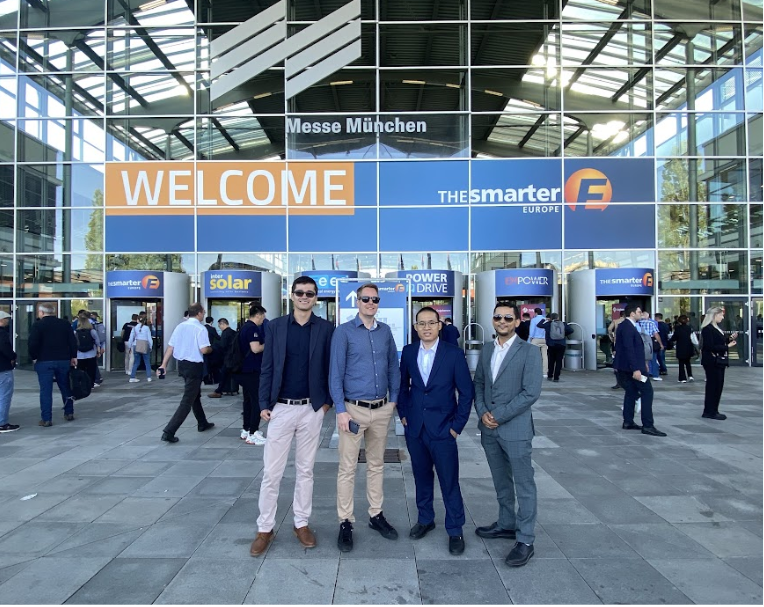
Author: Minh Quan Dang, Technical Supervisor
Posts you might like:

Subscribe to our newsletter
so that you don’t miss any news!






